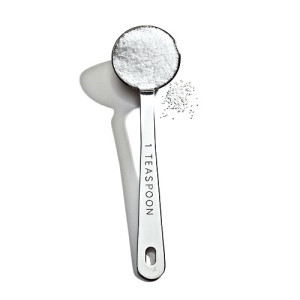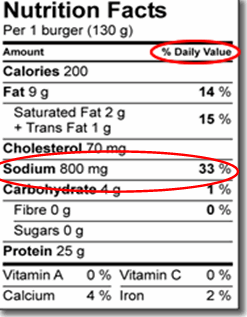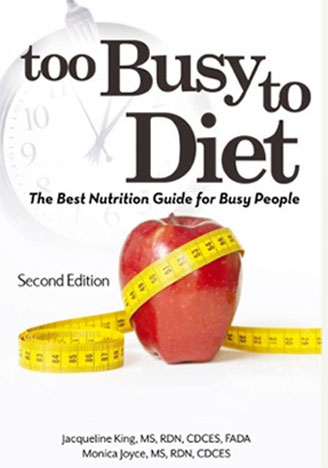HOLD the Salt Please!
in The Too Busy to Diet Blog on February 23, 2014

Written by Teri R. Belisle, PharmD, RD, LDN.
Valentine’s Day was last week but we are still talking about matters of the heart all February long. As I discussed a couple weeks ago, having diabetes significantly increases your risk of developing heart disease. Adding high blood pressure into the equation increases your risk even more.
High sodium, or salt, in the diet is strongly linked to increased blood pressure. Some may think that if they do not have problems with their blood pressure or they do not have a family history of blood pressure problems, they do not have to worry about how much sodium they eat. This is not true! As sodium intake increases, so does blood pressure. Some people however are more sensitive to sodium and are referred to as “salt sensitive”. This means that salt increases their blood pressure more drastically than it may in others. People likely to be “salt sensitive” are individuals over age 51, African Americans, those currently with high blood pressure, and those with a family history of such.
So how much sodium is too much?
The 2010 Dietary Guidelines recommend a maximum of 2,300 mg of sodium per day for most individuals. That’s equal to about 1 teaspoonful of salt. The Insitute of Medicine recommends just 1,500 mg (2/3 of a teaspoonful) per day for those who are “salt sensitive”.
How much salt are you eating?
The average American consumes up to 5,000 mg of sodium per day!
So why are we eating so much salt? Well, salt is everywhere, or at least it seems to be! Most foods contain some amount of natural sodium, but the majority that is consumed in the average American’s diet is from processed or packaged foods. This includes fast foods, canned goods, frozen meals, and packaged chips and crackers, just to name a few.
So how can you avoid so much sodium?
The ideal way to avoid unnecessary sodium in your diet is to eat more fresh foods such as fresh meats, fruits, and vegetables, and to limit the use of prepackaged items and fast foods. When prepackaged or convenience foods are used, reading the nutrition labels is a great way to avoid unwanted sodium and to help you make better choices when trying to reduce your sodium intake.
Understanding the label…
 Nutrition labels can be very confusing if you don’t know what you are looking for. An easy way to tell if a food is high in sodium is to look at the %DV (Percent Daily Value). The % DV tells you what portion of the daily recommended amount of sodium will be consumed in one serving of that particular food item. For example, if the %DV of a food serving is 5% or less, then the item is low in sodium. If %DV is 20% or more, then the item is high in sodium. Another way to tell is if a food is high in sodium is to look at the mg of sodium per serving. More than 460mg per serving is considered high, while 115mg or less is considered low. Also looking for key words such as “no salt added” and “low sodium” is helpful, but sometimes confusing. Here is a breakdown of the common terms used on food packages and what they mean:
Nutrition labels can be very confusing if you don’t know what you are looking for. An easy way to tell if a food is high in sodium is to look at the %DV (Percent Daily Value). The % DV tells you what portion of the daily recommended amount of sodium will be consumed in one serving of that particular food item. For example, if the %DV of a food serving is 5% or less, then the item is low in sodium. If %DV is 20% or more, then the item is high in sodium. Another way to tell is if a food is high in sodium is to look at the mg of sodium per serving. More than 460mg per serving is considered high, while 115mg or less is considered low. Also looking for key words such as “no salt added” and “low sodium” is helpful, but sometimes confusing. Here is a breakdown of the common terms used on food packages and what they mean:
| Salt free (sodium free) | Less than 5mg of sodium per serving |
| No Salt Added | No salt added during processing; does not mean sodium-free |
| Very Low Sodium | 35mg or less per serving |
| Low Sodium | 140mg or less per serving |
| Light in Sodium | 50% less sodium as compared to a standard serving of the traditional item (restricted to items that have more than 40 calories and more than 3 grams of fat per serving.) |
| Less Sodium or Reduced Sodium | Minimum of 25% less sodium per serving than the traditional item. |
For fun I decided to look at the labels of some food items I found in my cabinet at home. It is amazing how a little label reading can really open your eyes. Needless to say, some of these items are going to be tossed after looking at them a little closer.
- TOMATO SAUCE (½ cup serving): “original” = 280mg per serving vs. “no salt added” = 20mg per serving. The “no salt added” version saves 260 mg of sodium per serving! The choice is obvious here!
- TACO SEASONING, 1oz package (serving size 2 tablespoons): 430mg per serving (18% DV). There are 6 servings in the package = 2,580mg for the entire package. If you add the entire package to your ground beef or turkey, that is a lot of added salt! Next time try using only a ¼ of the package or making your own flavor combination with garlic powder, chili powder, cayenne pepper, and paprika.
- MAC & CHEESE, 6 oz box (serving size 1 cup): 550mg per serving (23%DV). There are 2 ½ serving per box, which equals 1,375mg of sodium per box. Please do yourself a favor and be aware of portions! DO NOT eat the entire box!
- HAMBURGER HELPER, 5.8 oz. box (serving size 1 cup): 760mg per serving (32%DV). There are 5 servings in one box which equals 3,800mg sodium in the whole box! Wow, please do your heart an even bigger favor and just don’t eat this! (Mine is going in the garbage asap!)
As you can see, taking a little time to read the labels and compare items can really help you make better choices. Remember it is important to keep portion sizes in mind and to just say no to those items that are extremely high in sodium.
Here are some additional ways to help reduce your sodium intake.
- Buy fresh or frozen vegetables.
- If buying canned vegetables, look for “no salt added” or rinse the vegetable under water before cooking to remove excess salt.
- Limit use of canned, cured, smoked or processed meats.
- Avoid packaged or convenience items (think boxed rices, noodle packets, boxed meals)
- Limit pickled foods- pickles, olives, sauerkraut, pickled beets, etc.
- Limit condiments that are high in salt – soy sauce, garlic salt, bouillon cubes, salad dressings.
- Limit salty snacks such as chips, pretzels, crackers. Look for unsalted versions.
- Limit fast-food. Review nutrition contents on restaurant websites.
- Order smart when dining out. Avoid breaded, fried, and marinated foods. Avoid soups, extra sauces. Ask for your food to be prepared by steaming, grilling, or baking.
- Avoid added salt while cooking. Use spices and herbs (dill, garlic, oregano, rosemary, etc.) to flavor foods.
- Remove the salt shaker from the dinner table!
- Read food labels!
Keep reading our blog, following us on Facebook, and check out the book Too Busy to Diet to find ways to keep your heart happy and healthy!
Buy the Too Busy to Diet book
Get your copy of the definitive diet reference guide and healthy eating book today. Stop reading those misleading fad diet books and read an easy to follow book on how to lose weight and keep it off from actual Registered Dietitians.

Recent Posts
- Barbeque Turkey Meatloaf
- Pescado a la Veracruzana
- Juicy Pork Chops
- Rotasserie Chicken Casserole
- Grilled Salmon & Blueberry Salad